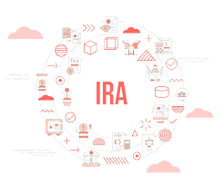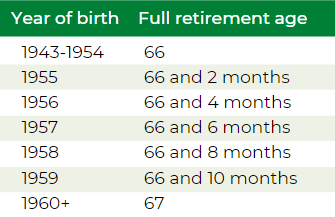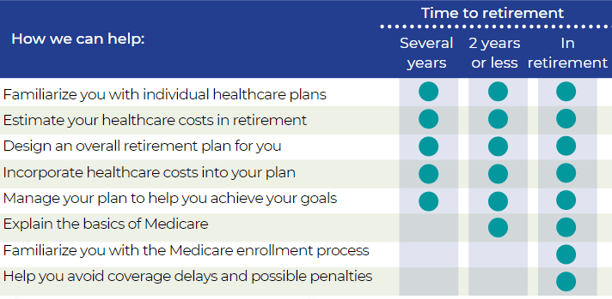Retirement Guide for Intel Employees
By: David Else & Derek Green
Authors:

David Else - Senior Vice President, Financial Advisor RICP®, CKA

Derek Green - Senior Vice President, Financial Advisor
In our comprehensive retirement guide for Intel employees, we go through many factors which you may take into account when deciding on the proper time to retire from Intel. Some of those factors include: healthcare & benefit changes, interest rates, the new 2024 tax rates, inflation, and much more. Keep in mind we are not affiliated with Intel, and we recommend reaching out to your Corporate benefits department for further information.
Table of Contents
2024 Tax Changes & Inflation

It is imperative for individuals to be aware of new changes made by the IRS. The main factors that will impact employees will be the following:
- The 2024 standard deduction will increase to $14,600 for single filers and those married filing separately, $29,200 for joint filers, and $21,900 for heads of household.
- Taxpayers who are over the age of 65 or blind can add an additional $1,550 to their standard deduction. That amount jumps to $1,950 if also unmarried or not a surviving spouse.
Retirement account contributions: Contributing to your company's 401k plan can cut your tax bill significantly, and the amount you can save has increased for 2024. The amount individuals can contribute to their 401(k) plans in 2024 will increase to $23,000 -- up from $22,500 for 2023. The catch-up contribution limit for employees age 50 and over will increase to $7,500.
There are important changes for the Earned Income Tax Credit (EITC) that you, as a taxpayer employed by a corporation, should know:
- The tax year 2024 maximum Earned Income Tax Credit amount is $7,830 for qualifying taxpayers who have three or more qualifying children, up from $7,430 for tax year 2023.
- Married taxpayers filing separately can qualify: You can claim the EITC as married filing separately if you meet other qualifications. This was not available in previous years.
Deduction for cash charitable contributions: The special deduction that allowed single nonitemizers to deduct up to $300—and married filing jointly couples to deduct $600— in cash donations to qualifying charities has expired.
Child Tax Credit changes:
- The maximum tax credit per qualifying child is $2,000 for children five and under – or $3,000 for children six through 17 years old. Additionally, you can't receive a portion of the credit in advance, as was the case in 2023.
- As a parent or guardian, you are eligible for the Child Tax Credit if your adjusted gross income is less than $200,000 when filing individually or less than $400,000 if you're filing a joint return with a spouse.
- A 70 percent, partial refundability affecting individuals whose tax bill falls below the credit amount.
2024 Tax Brackets

Inflation reduces purchasing power over time as the same basket of goods will cost more as prices rise. In order to maintain the same standard of living throughout your retirement after leaving your company, you will have to factor rising costs into your plan. While the Federal Reserve strives to achieve a 2% inflation rate each year, in 2023 that rate shot up to 4.9% which was a drastic increase from 2020’s 1.4%. While prices as a whole have risen dramatically, there are specific areas to pay attention to if you are nearing or in retirement from your company, like healthcare.
It is crucial to take all of these factors into consideration when constructing your holistic plan for retirement from your company.
*Source: IRS.gov, Yahoo, Bankrate, Forbes
Planning Your Retirement

Retirement planning is a verb; consistent action must be taken whether you’re 20 or 60.
The truth is that most Americans don’t know how much to save or the amount of income they’ll need.
No matter where you stand in the planning process, or your current age, we hope this guide provides you a good overview of the steps to take and resources that help you simplify your transition from your company into retirement and get the most from your benefits.
You know you need to be saving and investing, especially since time is on your side the sooner you start, but you don’t have the time or expertise to know if you’re building retirement savings that can last after leaving your company.
"A separate study by Russell Investments, a large money management firm, came to a similar conclusion. Russell estimates a good financial advisor can increase investor returns by 3.75 percent."
Source: Is it Worth the Money to Hire a Financial Advisor? The Balance, 2021
Starting to save as early as possible matters. Time on your side means compounding can have significant impacts on your future savings. And, once you’ve started, continuing to increase and maximize your contributions for your 401(k) plan is key.

There's a 79% potential boost in wealth at age 65 over a 20-year period when choosing to invest in your company's retirement plan.
*Source: Bridging the Gap Between 401(k) Sponsors and Participants, T.Rowe Price, 2020
As decades go by, you’re likely full swing into your career at your company and your income probably reflects that. However, the challenges of saving for retirement start coming from large competing expenses: a mortgage, raising children, and saving for their college.
One of the classic planning conflicts is saving for retirement versus saving for college. Most financial planners will tell you that retirement from your company should be your top priority because your child can usually find support from financial aid while you’ll be on your own to fund your retirement.
How much we recommend that you invest towards your retirement is always based on your unique financial situation and goals. However, consider investing a minimum of 10% of your salary toward retirement through your 30s and 40s.
As you enter your 50s and 60s, you’re ideally at your peak earning years with some of your major expenses, such as a mortgage or child-rearing, behind you or soon to be in the rearview mirror. This can be a good time to consider whether you have the ability to boost your retirement savings goal to 20% or more of your income. For many people, this could potentially be the last opportunity to stash away funds.
In 2024, workers age 50 or older can invest up to $23,000 into their retirement plan/401(k), and once they meet this limit, they can add an additional $7,500 in catch-up contributions for a combined annual total of $30,500. These limits are adjusted annually for inflation.
Why are 401(k)s and matching contributions so popular?
These retirement savings vehicles give you the chance to take advantage of three main benefits:
- Compound growth opportunities (as seen above)
- Tax saving opportunities
- Matching contributions
Matching contributions are just what they sound like: your company matches your own 401(k) contributions with money that comes from the company. If your company matches, the company money typically matches up to a certain percent of the amount that you put in.
Unfortunately, many people fail to take advantage of their company's matching contributions because they’re not contributing the required minimum to receive the full company match.
According to Bank of America's "2022 Financial Life Benefit Impact Report", despite 58% of eligible employees participating in a 401(k) plan, 61% of them contributed less than $5,000 during the current year.
The study also found that fewer than one in 10 participants’ contributions reached the ceiling on elective deferrals, under IRS Section 402(g) — which is $23,000 for 2024.
A 2020 study from Financial Engines titled “Missing Out: How Much Employer 401(k) Matching Contributions Do Employees Leave on the Table?”, revealed that employees who don’t maximize their company match typically leaves $1,336 of extra retirement money on the table each year.
For example, if your company will match up to 3% of your plan contributions and you only contribute 2% of your salary, you aren’t getting the full amount of the company match. By simply increasing your contribution by just 1%, your company is now matching the full 3% of your contributions for a total combined contribution of 6%. By doing so, you aren’t leaving money on the table.
Your Pension Plan

Retirement Contribution Account
Intel’s Retirement Contribution Account (RCA) is a key component of the company's retirement benefits, designed to supplement employees' retirement savings. The RCA is company-funded and provides additional contributions to an employee’s retirement account, independent of their own contributions to the 401(k) plan.
The RCA is a non-elective employer contribution that Intel makes on behalf of its employees. Unlike 401(k) matching contributions, which are based on the employee's own contributions, the RCA is entirely funded by Intel. The contributions are calculated as a percentage of the employee’s eligible compensation and are made regardless of whether the employee contributes to the 401(k) plan.
Eligibility
● Who is Eligible: The RCA is typically available to most full-time employees at Intel who are eligible for the company's retirement plans. Eligibility usually begins after a certain period of employment, although specific eligibility criteria may vary depending on the employee's hire date and other factors.
● Vesting: Contributions to the RCA vest over time. Typically, Intel’s vesting schedule for RCA contributions is 3 years, meaning employees must complete three years of service to be fully vested in the contributions. If an employee leaves before completing the vesting period, they may forfeit the unvested portion of the account.
Contribution Rates
Intel’s contributions to the RCA are based on a percentage of the employee’s eligible compensation. The specific contribution rate may vary based on the employee's age and years of service. For example:
● Employees under a certain age (e.g., under 50) might receive a contribution of 4% of their eligible compensation.
● Employees over that age threshold might receive a higher contribution rate, such as 5% of their eligible compensation.
These contributions are made annually and are designed to help employees build a more secure retirement by supplementing their other retirement savings.
Investment Options
The RCA funds are invested in a manner similar to other retirement accounts. Employees typically have the ability to choose from a variety of investment options offered by Intel, which may include mutual funds, target-date funds, and other investment vehicles. The account grows based on the performance of the chosen investments, and the value of the account at retirement will depend on these investment returns.
Example Calculation
Scenario:
● Annual Salary: $100,000
● Contribution Rate: 4% for employees under 50 years old
Calculation:
● Intel’s RCA Contribution = 4% of $100,000 = $4,000
If an employee earns $100,000 annually and is under 50, Intel would contribute $4,000 to their RCA for that year. Over time, with the investment growth and additional annual contributions, this account can significantly enhance the employee’s retirement savings.
Intel's Minimum Pension Plan (MPP)
Intel's Minimum Pension Plan (MPP) benefit is designed to provide a minimum level of retirement income for eligible employees. The MPP acts as a safety net, ensuring that retirees receive a certain base amount of retirement income if their primary retirement savings (like the Retirement Contribution Account or RCA) fall short.
The MPP is a type of defined benefit plan, meaning it guarantees a specific retirement benefit amount. However, it is structured as a minimum benefit plan, meaning it only kicks in if the value of the employee’s Retirement Contribution Account (RCA) is insufficient to provide a pre-determined level of retirement income.
Intel calculates the pension benefit using two main factors:
Final Average Pay: This is the average of an employee's highest earnings over a certain period, typically the last five years of service.
Years of Service: The longer an employee works at Intel, the higher their pension benefit, as it is multiplied by their years of service.
Intel compares the calculated pension benefit with the RCA balance. If the RCA balance can produce an income equal to or greater than the minimum pension benefit, the employee will only receive the RCA balance. If the RCA balance is less than the calculated pension benefit, Intel provides an additional benefit to make up the shortfall.
Eligibility
To be eligible for the MPP, employees must meet one of the following:
- Rule of 75: to The Rule of 75 is the sum of the participants age plus years of service. The combined total of the participant's age plus years of service must be equal to or greater than 75.
- Age 65: Participant must be at least 65 years old with no minimum years of service requirement. This is known as normal retirement age.
- 55 & 15: Participant must be at least 55 years old and complete a minimum of 15 years of eligible service
Meeting any one of the above requirements will allow the participant to be eligible for the retiree benefits program.
Example Calculation
Scenario:
Final Average Pay: $100,000
Years of Service: 20 years
RCA Balance: $150,000
Assumed Annuity Factor: 15
Step 1: Calculate the Pension Benefit:
Pension Benefit = Final Average Pay x Years of Service x Pension Multiplier
Assuming a Pension Multiplier of 1.5%, the annual pension benefit would be:
$100,000 x 20 x 1.5% = $30,000 per year
Step 2: Calculate the RCA-Generated Income:
RCA Income = RCA Balance / Annuity Factor
$150,000 / 15 = $10,000 per year
Step 3: Compare the Two:
Since the RCA-Generated Income ($10,000) is less than the Pension Benefit ($30,000), Intel would provide an additional $20,000 per year through the MPP to meet the minimum benefit.
Intel's Sheltered Employee Retirement Plan Plus (SERPLUS) is a non-qualified deferred compensation plan designed to provide additional retirement savings opportunities for a select group of management or highly compensated employees. The plan allows eligible employees to defer a portion of their income and bonuses, supplementing their qualified retirement plan savings beyond the limits imposed by the IRS.
Eligibility
Who is Eligible: SERPLUS is available to a specific group of Intel employees classified as management or highly compensated. For the 2020 Plan Year, eligible employees were those in Grades 10-20, 25-28, 46-49, and 85-90. This includes senior managers and executives who exceed the contribution limits of qualified plans like the 401(k) plan.
Exclusions: Employees covered by collective bargaining agreements, nonresident aliens without U.S. earned income, independent contractors, interns, and employees not on Intel’s U.S. payroll system are not eligible for SERPLUS participation.
Plan Contributions
Employee Deferrals: Eligible employees can defer a portion of their salary (up to a certain percentage) and bonuses into the SERPLUS plan. These deferrals are made on a pre-tax basis, allowing employees to reduce their taxable income in the year the deferral is made.
Company Contributions: Intel may make discretionary contributions, known as Supplemental Contributions, to the SERPLUS accounts of eligible employees. Additionally, Intel provides Matching Contributions, which for the 2020 Plan Year, matched 5% of the employee’s Excess Earnings (earnings above certain IRS limits).
Vesting
Employee Deferrals: Contributions made by the employee are always 100% vested, meaning the employee has full ownership of these funds from the moment they are contributed.
Company Contributions: Intel’s contributions to the SERPLUS plan vest based on a schedule. Generally, employees become 100% vested in these contributions after completing six years of service. Employees who attain age 60, die, or become permanently and totally disabled while employed also become fully vested.
Payouts and Distributions
Distribution Options: Employees can choose when and how to receive their SERPLUS account balance upon retirement or separation from Intel. Options include lump-sum payments or installment payments over a period of years. Employees may also elect to receive in-service distributions, allowing them to access funds while still employed, under specific conditions.
Tax Implications: Since SERPLUS is a non-qualified plan, contributions are not subject to income tax until distributed. However, the funds are subject to Social Security and Medicare taxes at the time of deferral.
Example Calculation
Scenario: Assume an eligible employee earns $300,000 annually and chooses to defer 10% of their salary into the SERPLUS plan. Intel provides a 5% match on the Excess Earnings (income above the IRS limit, which for 2020 was $285,000).
Employee Deferral: 10% of $300,000 = $30,000
Excess Earnings: $300,000 - $285,000 = $15,000
Intel Match: 5% of $15,000 = $750
Total Contribution for the Year: $30,750
This example illustrates how the SERPLUS plan allows highly compensated employees to defer substantial income and receive additional company contributions beyond traditional retirement savings limits.
Lump-Sum vs. Annuity
Retirees who are eligible for a pension are often offered the choice of receiving their pension payments for life, or receive a lump-sum amount all-at-once. The lump sum is the equivalent present value of the monthly pension income stream – with the idea that you could then take the money (rolling it over to an IRA), invest it, and generate your own cash flow by taking systematic withdrawals throughout your retirement years.
The upside of electing the monthly pension is that the payments are guaranteed to continue for life (at least to the extent that the pension plan itself remains in place and solvent and doesn’t default). Thus, whether you live 10, 20, 30, or more years after retiring from your company, you don’t have to worry about the risk of outliving the monthly pension.
The major downside of the monthly pension are the early and untimely passing of the retiree and joint annuitant. This often translates into a reduction in the benefit or the pension ending altogether upon the passing. The other downside, it that, unlike Social Security, company pensions rarely contain a COLA (Cost of Living Allowance). As a result, with the dollar amount of monthly pension remaining the same throughout retirement, it will lose purchasing power when the rate of inflation increases.

In contrast, selecting the lump-sum gives you the potential to invest, earn more growth, and potentially generate even greater retirement cash flow. Additionally, if something happens to you, any unused account balance will be available to a surviving spouse or heirs. However, if you fail to invest the funds for sufficient growth, there’s a danger that the money could run out altogether and you may regret not having held onto the pension’s “income for life” guarantee.
Ultimately, the “risk” assessment that should be done to determine whether or not you should take the lump sum or the guaranteed lifetime payments that your company pension offers, depends on what kind of return must be generated on that lump-sum to replicate the payments of the annuity. After all, if it would only take a return of 1% to 2% on that lump-sum to create the same monthly pension cash flow stream, there is less risk that you will outlive the lump-sum. However, if the pension payments can only be replaced with a higher and much riskier rate of return, there is, in turn, a greater risk those returns won’t manifest and you could run out of money.
Intel’s Pension Distribution Options
Intel offers a variety of distribution options for its pension plans, allowing employees to tailor their retirement payouts to their personal financial needs. Intel’s pension plans include the traditional pension plan as well as other supplemental retirement options, such as the Sheltered Employee Retirement Plan Plus (SERPLUS) and the Retirement Contribution Account (RCA). Here’s a breakdown of the distribution options available to Intel employees upon retirement or separation:
1. Lump-Sum Payment
How It Works: This option allows employees to receive their entire pension benefit in a one-time lump-sum payment. Once the lump-sum is paid, Intel no longer holds any obligations to the retiree under the pension plan.
Advantages: Provides immediate access to the full pension amount, offering flexibility for those who want to invest the money, pay off debts, or make large purchases.
Disadvantages: The lump sum is fully taxable (unless rolled over into a qualified retirement account), and there is a risk of depleting the funds if not managed carefully.
2. Monthly Annuity Payments
How It Works: Employees can elect to receive their pension as a series of monthly payments over their lifetime. Payments can also be structured to continue for a spouse or beneficiary after the retiree’s death.
Advantages: Guarantees a steady income stream for life, providing financial security and protection against outliving one’s savings.
Disadvantages: Once payments begin, they cannot be changed, and if the retiree dies early, there may be less total benefit received compared to a lump-sum option.
3. Joint and Survivor Annuity
How It Works: This option allows the employee to receive reduced monthly payments during their lifetime, with a portion continuing to be paid to a spouse or beneficiary after the retiree’s death. Common choices include 50%, 75%, or 100% continuation for the survivor.
Advantages: Provides income security for a spouse or beneficiary in case of the retiree’s death.
Disadvantages: The retiree’s monthly payment amount is reduced to account for the survivor benefit.
4. Installment Payments
How It Works: Instead of a lump-sum or lifetime annuity, retirees can elect to receive their pension benefits in installments over a specific period, such as 5 or 10 years. This option provides a middle ground between a lump sum and a lifetime annuity.
Advantages: Provides structured payments for a set period, giving retirees control over when and how they receive their pension.
Disadvantages: Once the installment period ends, no further payments will be made, and there is the risk of outliving the payments.
5. In-Service Distributions
How It Works: Intel’s SERPLUS plan allows employees to take distributions from their deferred compensation while still employed, provided certain conditions are met. This option is typically used for employees who have deferred a significant portion of their income and want to access the funds before retiring.
Advantages: Offers flexibility to access funds while still working.
Disadvantages: Distributions are subject to income tax, and accessing the funds early could reduce long-term retirement savings.
Key Considerations
Tax Implications: Pension distributions are generally taxed as ordinary income. Lump-sum payments can be rolled over into a traditional IRA or other qualified plan to defer taxes, while annuity and installment payments are taxed when received.
Survivor Benefits: Employees should carefully consider their family situation and financial needs when selecting joint and survivor annuity options, ensuring their spouse or beneficiaries are financially protected.
Interest Rates and Life Expectancy
Current interest rates, as well as your life expectancy at retirement, have a significant impact on lump sum payouts of defined benefit pension plans.
Rising interest rates have an inverse relationship to pension lump sum values. The reverse is also true; decreasing or lower interest rates will increase pension lump sum values. Interest rates are important for determining your lump sum option within the pension plan.
The Retirement Group believes all employees should obtain a detailed RetireKit Cash Flow Analysis comparing their lump sum value versus the monthly annuity distribution options, before making their pension elections.
As enticing as a lump sum may be, the monthly annuity for all or a portion of the pension, may still be an attractive option, especially in a high interest rate environment.
Each person’s situation is different, and a complimentary Cash Flow Analysis, from The Retirement Group, will show you how your pension choices stack up and play out over the course of your retirement years which may be two, three, four or more decades in retirement.

By knowing where you stand, you can make a more prudent decision regarding the optimal time to retire, and which pension distribution option meets your needs the best.
Your 401(k) Plan

401(k) Savings Plan
Employees are encouraged to enroll in the Intel 401(k) savings plan right away. You may invest on a before-tax and/or an after-tax basis (regular or Roth) with a wide array of options and funds for all levels of investors.
Employer Match
Intel currently provides an employer match up to 7% of your eligible pay.
Please note that the company match has fluctuated over the years.
Vesting
As a participant, you currently vest in the company match immediately.
Similar to the fluctuations with the company match, the vesting period has also fluctuated from time to time over the years.
Next Steps:
When you retire, if you have balances in your 401(k) plan, you will receive a Participant Distribution Notice in the mail. This notice will show the current value that you are eligible to receive from each plan and explain your distribution options. It will also tell you what you need to do to receive your final distribution. Please call The Retirement Group at (800)-900-5867 for more information and we can get you in front of a retirement-focused advisor.
- Watch for your Participant Distribution Notice and Special Tax Notice Regarding Plan Payments. These notices will help explain your options and what the federal tax implications may be for your vested account balance.
- "What has Worked in Investing" & "8 Tenets when picking a Mutual Fund".
- To learn about your distribution options, call The Retirement Group at (800)-900-5867. Click our e-book for more information on "Rollover Strategies for 401(k)s". Use the Online Beneficiary Designation to make updates to your beneficiary designations, if needed.
Over half of plan participants admit they don’t have the time, interest or knowledge needed to manage their 401(k) portfolio. But the benefits of getting help goes beyond convenience. Studies like this one, from Charles Schwab, show those plan participants who get help with their investments tend to have portfolios that perform better: The annual performance gap between those who get help and those who do not is 3.32% net of fees. This means a 45-year-old participant could see a 79% boost in wealth by age 65 simply by contacting an advisor. That’s a pretty big difference.
Getting help can be the key to better results across the 401(k) board.
A Charles Schwab study found several positive outcomes common to those using independent professional advice. They include:
- Improved savings rates – 70% of participants who used 401(k) advice increased their contributions.
- Increased diversification – Participants who managed their own portfolios invested in an average of just under four asset classes, while participants in advice-based portfolios invested in a minimum of eight asset classes.
- Increased likelihood of staying the course – Getting advice increased the chances of participants staying true to their investment objectives, making them less reactive during volatile market conditions and more likely to remain in their original 401(k) investments during a downturn. Don’t try to do it alone. Get help with your company's 401(k) plan investments. Your nest egg will thank you.
It’s important to know that certain withdrawals are subject to regular federal income tax and, if you’re under age 59½, you may also be subject to an additional 10% penalty tax. You can determine if you’re eligible for a withdrawal, and request one, online or by calling your company's Benefits Center.
Rolling Over Your 401(k)
Because a withdrawal permanently reduces your retirement savings and is subject to tax, you should always consider taking a loan from the plan instead of a withdrawal to meet your financial needs. Unlike withdrawals, loans must be repaid, and are not taxable (unless you fail to repay them). In some cases, as with hardship withdrawals, you are not allowed to make a withdrawal unless you have also taken out the maximum loan available within the company plan.
You should also know that your company's plan administrator reserves the right to modify the rules regarding withdrawals at any time, and may further restrict or limit the availability of withdrawals for administrative or other reasons. All plan participants will be advised of any such restrictions, and they apply equally to all corporate employees.
Borrowing from your 401(k)
Should you? Maybe you lose your job with your company, have a serious health emergency, or face some other reason that you need a lot of cash. Banks make you jump through too many hoops for a personal loan, credit cards charge too much interest, and … suddenly, you start looking at your 401(k) account and doing some quick calculations about pushing your retirement from your company off a few years to make up for taking some money out.
We understand how you feel: It’s your money, and you need it now. But, take a second to see how this could adversely affect your retirement plans after leaving your company.
Consider these facts when deciding if you should borrow from your 401(k). You could:
- Lose growth potential on the money you borrowed.
- Deal with repayment and tax issues if you leave your company.
- Repayment and tax issues, if you leave your company.
Net Unrealized Appreciation (NUA)
When you qualify for a distribution, you have three options:
- Roll-over your qualified plan to an IRA and continue deferring taxes.
- Take a distribution and pay ordinary income tax on the full amount.
- Take advantage of NUA and reap the benefits of a more favorable tax structure on gains.
How does Net Unrealized Appreciation work?
First an employee must be eligible for a distribution from their qualified company-sponsored plan. Generally, at retirement or age 59 1⁄2, the employee takes a 'lump-sum' distribution from the plan, distributing all assets from the plan during a 1-year period. The portion of the plan that is made up of mutual funds and other investments can be rolled into an IRA for further tax deferral. The highly appreciated company stock is then transferred to a non-retirement account.
The tax benefit comes when you transfer the company stock from a tax-deferred account to a taxable account. At this time, you apply NUA and you incur an ordinary income tax liability on only the cost basis of your stock. The appreciated value of the stock above its basis is not taxed at the higher ordinary income tax but at the lower long-term capital gains rate, currently 15%. This could mean a potential savings of over 30%.
You may be interested in learning more about NUA with a complimentary one-on-one session with a financial advisor from The Retirement Group.
IRA Withdrawal
When you qualify for a distribution, you have three options:
Your retirement assets may consist of several retirement accounts: IRAs, 401(k)s, taxable accounts, and others.
So, what is the most efficient way to take your retirement income after leaving your company?
You may want to consider meeting your income needs in retirement by first drawing down taxable accounts rather than tax-deferred accounts.
This may help your retirement assets with your company last longer as they continue to potentially grow tax deferred.
You will also need to plan to take the required minimum distributions (RMDs) from any company-sponsored retirement plans and traditional or rollover IRA accounts.
That is due to IRS requirements for 2024 to begin taking distributions from these types of accounts when you reach age 73. Beginning in 2024, the excise tax for every dollar of your RMD under-distributed is reduced from 50% to 25%.
There is new legislation that allows account owners to delay taking their first RMD until April 1 following the later of the calendar year they reach age 73 or, in a workplace retirement plan, retire.
Two flexible distribution options for your IRA
When you need to draw on your IRA for income or take your RMDs, you have a few choices. Regardless of what you choose, IRA distributions are subject to income taxes and may be subject to penalties and other conditions if you’re under 59½.
Partial withdrawals: Withdraw any amount from your IRA at any time. If you’re 73 or over, you’ll have to take at least enough from one or more IRAs to meet your annual RMD.
Systematic withdrawal plans: Structure regular, automatic withdrawals from your IRA by choosing the amount and frequency to meet your income needs after retiring from your company. If you’re under 59½, you may be subject to a 10% early withdrawal penalty (unless your withdrawal plan meets Code Section 72(t) rules).
Your tax advisor can help you understand distribution options, determine RMD requirements, calculate RMDs, and set up a systematic withdrawal plan.
Your Benefits

HSA's
Health Savings Accounts (HSAs) are often celebrated for their utility in managing healthcare expenses, particularly for those with high-deductible health plans. However, their benefits extend beyond medical cost management, positioning HSAs as a potentially superior retirement savings vehicle compared to traditional retirement plans like 401(k)s, especially after employer matching contributions are maxed out.
Understanding HSAs
HSAs are tax-advantaged accounts designed for individuals with high-deductible health insurance plans. For 2024, the IRS defines high-deductible plans as those with a minimum deductible of $1,600 for individuals and $3,200 for families. HSAs allow pre-tax contributions, tax-free growth of investments, and tax-free withdrawals for qualified medical expenses—making them a triple-tax-advantaged account.
The annual contribution limits for HSAs in 2024 are $4,150 for individuals and $8,300 for families, with an additional $1,000 allowed for those aged 55 and older. Unlike Flexible Spending Accounts (FSAs), HSA funds do not expire at the end of the year; they accumulate and can be carried over indefinitely.
Comparing HSAs to 401(k)s Post-Matching
Once an employer's maximum match in a 401(k) is reached, further contributions yield diminished immediate financial benefits. This is where HSAs can become a strategic complement. While 401(k)s offer tax-deferred growth and tax-deductible contributions, their withdrawals are taxable. HSAs, in contrast, provide tax-free withdrawals for medical expenses, which are a significant portion of retirement costs.
HSA as a Retirement Tool
Post age 65, the HSA flexes its muscles as a robust retirement tool. Funds can be withdrawn for any purpose, subject only to regular income tax if used for non-medical expenses. This flexibility is akin to that of traditional retirement accounts, but with the added advantage of tax-free withdrawals for medical costs—a significant benefit given the rising healthcare expenses in retirement.
Furthermore, HSAs do not have Required Minimum Distributions (RMDs), unlike 401(k)s and Traditional IRAs, offering more control over tax planning in retirement. This makes HSAs particularly advantageous for those who might not need to tap into their savings immediately at retirement or who want to minimize their taxable income.
Investment Strategy for HSAs
Initially, it's prudent to invest conservatively within an HSA, focusing on ensuring that there are sufficient liquid funds to cover near-term deductible and other out-of-pocket medical expenses. However, once a financial cushion is established, treating the HSA like a retirement account by investing in a diversified mix of stocks and bonds can significantly enhance the account's growth potential over the long term.
Utilizing HSAs in Retirement
In retirement, HSAs can cover a range of expenses:
- Healthcare Costs-Pre Medicare: HSA's Can pay for healthcare costs to bridge you to Medicare
- Healthcare Costs-Post Medicare: HSAs can pay for Medicare premiums and out-of-pocket medical costs, including dental and vision, which are often not covered by Medicare.
- Long-term Care: Funds can be used for qualified long-term care services and insurance premiums.
- Non-medical Expenses: After age 65, HSA funds can be used for non-medical expenses without incurring penalties, although these withdrawals are subject to income tax.
Conclusion
In summary, HSAs offer unique advantages that can make them a superior option for retirement savings, particularly after the benefits of 401(k) matching are maximized. Their flexibility in fund usage, coupled with tax advantages, makes HSAs an essential component of a comprehensive retirement strategy. By strategically managing contributions and withdrawals, individuals can maximize their financial health in retirement, keeping both their medical and financial well-being secure.
Intel Sheltered Employee Retirement Medical Account
The Intel Sheltered Employee Retirement Medical Account (SERMA) is a Health Reimbursement Arrangement (HRA) plan established for employees hired prior to January 1, 2014. The program is governed by the Intel Retiree Medical Plan (IRMP) and Sheltered Employee Retirement Medical Account (SERMA) Summary Plan Description (SPD).
- The SERMA plan year runs from January 1st through December 31st of each year. You may submit for premiums incurred during these dates as long as you file your claim after your coverage began and before the run-out period ends, which is May 31st of the following year.
- SERMA reimburses retirees for eligible medical insurance premium expenses for you, your qualified dependents, and your spouse/domestic partner until the balance is exhausted.
- The fund is established at the time you retire (45-60 days) and there are no additional funds, except small T-Bill interest rate adjustments each year
- SERMA is a Health Reimbursement Arrangement (HRA) and is not considered taxable income; no W-2 or 1099 is issued.
- Your SERMA is forfeited if the account has not been used after 20 consecutive years.
Your life insurance coverage and any optional coverage you purchase for your spouse/domestic partner and/or children ends on the date your employment with your company ends, unless your employment ends due to disability. If you die within 31 days of your termination date from your company, benefits are paid to your beneficiary for your basic life insurance, as well as any additional life insurance coverage you elected.
Note:
-
You may have the option to convert your life insurance to an individual policy or elect portability on any optional coverage.
-
If you stop paying supplementary contributions, your coverage will end.
-
If you are at least 65 and you pay for supplemental life insurance, you should receive information in the mail from the insurance company that explains your options.
-
Make sure to update your beneficiaries. See your company's SPD for more details.
Next Step:
- When you retire, make sure that you update your beneficiaries, and update the Beneficiary Designation form for life events such as death, marriage, divorce, childbirth, adoptions, etc.
Intel's Stock Benefit Program
Intel's stock benefit program is an important part of your employees' overall compensation and benefits package.
Some things to keep in mind when you retire from Intel:
- Stock option vesting may accelerate upon retirement, if certain criteria are met. Restricted stock unit (RSU) vesting schedules may be impacted too. Unvested RSUs will be canceled as of your last day worked.
- Expiration and Vest dates—per your plan rules—will be updated in your stock account, typically within one week following entry of your termination date in Intel's system of record.
- Make sure to exercise your stock options before they expire. If your expiration dates fall on a US weekend or US holiday when the market is closed, you must exercise no later than a half-hour prior to the stock market closing on the last trading day prior to your expiration date. Remember stock market hours of operation are based on the US Eastern time zone.
- If you retire from Intel before the end of a Stock Purchase Plan (SPP) subscription period, you will receive a refund of your SPP contributions for that period in your final paycheck. You will not receive stock or interest on SPP contributions.
- Your Intel Employee stock account with E*TRADE will remain open for a period of 60 days after your last expiration date, at which point you may transfer your assets to a non-Intel stock account of your choice.
- You must contact the administrator with instructions for handling any assets remaining in your employee account within 18 months of your termination date. You may want to set up a personal retail account to transfer your assets to another broker.
Social Security & Medicare

Knowing the foundation of Social Security, and using this knowledge to your advantage, can help you claim your maximum benefit.
It’s your responsibility to enroll in Medicare parts A and B when you first become eligible — and you must stay enrolled to have coverage for Medicare-eligible expenses. This applies to your Medicare eligible dependents as well.
You should know how your retiree medical plan choices or Medicare eligibility impacts your plan options. Before you retire from your company, contact the U.S. Social Security Administration directly at 800-772-1213, call your local Social Security Office or visit ssa.gov.

You and your Medicare-eligible dependents must enroll in Medicare Parts A and B when you first become eligible. Medical and MH/SA benefits payable under the company's-sponsored plan will be reduced by the amounts Medicare Parts A and B would have paid whether you actually enroll in them or not.


Divorce

If you’re divorced or in the process of divorcing, your former spouse(s) may have an interest in a portion of your retirement benefits from your company. Before you can start your pension — and for each former spouse who may have an interest — you’ll need to provide your company with the following documentation:
- A copy of the court-filed Judgment of Dissolution or Judgment of Divorce along with any Marital Settlement Agreement (MSA)
- A copy of the court-filed Qualified Domestic Relations Order (QDRO)
You were married for at least 10 years prior to the divorce.
You are currently unmarried.
Your ex-spouse is entitled to Social Security benefits.
Unlike with a married couple, your ex-spouse doesn’t have to have filed for Social Security before you can apply for your divorced spouse’s benefit.
Divorce doesn’t disqualify you from survivor benefits. You can claim a divorced spouse’s survivor benefit if the following are true:
- Your ex-spouse is deceased.
- You are at least 60 years of age.
- You were married for at least 10 years prior to the divorce.
- You are single (or you remarried after age 60).
In the process of divorcing?
If your divorce isn’t final before your retirement date from your company, you’re still considered married. You have two options:
- Retire from your company before your divorce is final and elect a joint pension of at least 50% with your spouse — or get your spouse’s signed, notarized consent to a different election or lump sum.
- Delay your retirement from your company until after your divorce is final and you can provide the required divorce documentation.*
Source: The Retirement Group, “Retirement Plans - Benefits and Savings,” U.S. Department of Labor, 2019; “Generating Income That Will Last Throughout Retirement,” Fidelity, 2019
Survivor Checklist

In the unfortunate event that you aren’t able to collect your benefits from your company, your survivor will be responsible for taking action.
What your survivor needs to do:
- Report your death. Your spouse, a family member or even a friend should call your company’s benefits service center as soon as possible to report your death.
- Collect life insurance benefits. Your spouse, or other named beneficiary, will need to call your company's benefits service center to collect life insurance benefits.
If you have a joint pension:
- Start the joint pension payments. The joint pension is not automatic. Your joint pensioner will need to complete and return the paperwork from your company's pension center to start receiving joint pension payments.
- Be prepared financially to cover living expenses. Your spouse will need to be prepared with enough savings to bridge at least one month between the end of your pension payments from your company and the beginning of his or her own pension payments.
If your survivor has medical coverage through your company:
- Decide whether to keep medical coverage.
- If your survivor is enrolled as a dependent in your company-sponsored retiree medical coverage when you die, he or she needs to decide whether to keep it. Survivors have to pay the full monthly premium.
Life After Your Career

Make up for decreased value of savings or investments. Low interest rates make it great for lump sums but harder for generating portfolio income. Some people continue to work to make up for poor performance of their savings and investments.
Maybe you took an offer from your company and left earlier than you wanted with less retirement savings than you needed. Instead of drawing down savings, you may decide to work a little longer to pay for extras you’ve always denied yourself in the past.
Meet financial requirements of day-to-day living. Expenses can increase during your retirement from your company and working can be a logical and effective solution. You might choose to continue working in order to keep your insurance or other benefits — many employers offer free to low cost health insurance for part-time workers.
You might find yourself with very tempting job opportunities at a time when you thought you’d be withdrawing from the workforce.
Staying active and involved. Retaining employment after your previous job, even if it’s just part-time, can be a great way to use the skills you’ve worked so hard to build over the years and keep up with friends and colleagues.
Enjoying yourself at work. Just because the government has set a retirement age with its Social Security program doesn’t mean you have to schedule your own life that way. Many people genuinely enjoy their employment and continue working because their jobs enrich their lives.
Sources
6.png)
- “National Compensation Survey: Employee Benefits in the United States, March 2019," Bureau of Labor Statistics, U.S. Department of Labor.
- “Generating Income That Will Last throughout Retirement.” Fidelity, 22 Jan. 2019, www.fidelity.com/viewpoints/retirement/income-that-can-last-lifetime.
- “Retirement Plans-Benefits & Savings.” U.S. Department of Labor, 2019, www.dol.gov/general/topic/retirement.
- AT&T Summary Plan Description, 2019
- Chevron Summary Plan Description, 2019
- Shell Summary Plan Description, 2019
- ExxonMobil Summary Plan Description, 2019
- https://seekingalpha.com/article/4268237-order-withdrawals-retirement-assets
- https://www.aon.com/empowerresults/ensuring-retirees-get-health-care-need/
- 8 Tenets when picking a Mutual Fund e-book
- Determining Cash Flow Need in Retirement e-book
- Early Retirement Offers e-book
- Lump Sum vs. Annuity e-book
- Social Security e-book
- Rising Interest Rates e-book
- Closing The Retirement Gap e-book
- Rollover Strategies for 401(k)s e-book
- How to Survive Financially After a Job Loss e-book
- Financial PTSD e-book
- RetireKit
- What has Worked in Investing e-book
- Retirement Income Planning for ages 50-65 e-book
- Strategies for Divorced Individuals e-book
- TRG Webinar for Corporate Employees
- Composite Corp Bond Rate history (10 years)http://www.irs.gov/retirement/article/0,,id=123229,00.html https://www.irs.gov/retirement-plans/composite-corporate-bond-rate-table
- IRS 72(t) code: https://www.irs.gov/retirement-plans/plan-participant-employee/retirement-topics-tax-on-early-distributions
- Missing out: How much employer 401(k) matching contributions do employees leave on the table?
- Jester Financial Technologies, Worksheet Detail - Health Care Expense Schedule
- Social Security Administration. Benefits Planner: Income Taxes and Your Social Security Benefits. Social Security Administration. Retrieved October 11, 2016 from https://www.ssa.gov/planners/taxes.html
- http://hr.chevron.com/northamerica/us/payprograms/executiveplans/dcp/
- https://www.lawinsider.com/contracts/1tRmgtb07oJJieGzlZ0tjL/chevron-corp/incentive-plan/2018-02-02
-
https://www.irs.gov/newsroom/irs-provides-tax-inflation-adjustments-for-tax-year-2022
-
https://news.yahoo.com/taxes-2022-important-changes-to-know-164333287.html
-
https://www.nerdwallet.com/article/taxes/federal-income-tax-brackets
-
https://www.the-sun.com/money/4490094/key-tax-changes-for-2022/
-
https://www.bankrate.com/taxes/child-tax-credit-2022-what-to-know/




